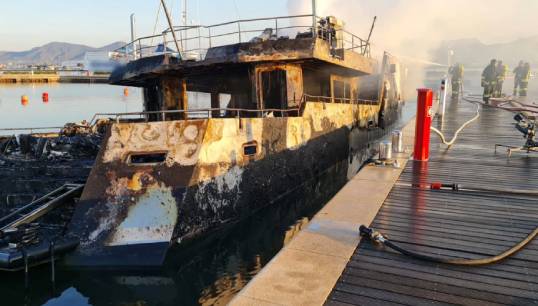- Topics
- Campaigning
- Careers
- Colleges
- Community
- Education and training
- Environment
- Equality
- Federation
- General secretary message
- Government
- Health and safety
- History
- Industrial
- International
- Law
- Members at work
- Nautilus news
- Nautilus partnerships
- Netherlands
- Open days
- Opinion
- Organising
- Switzerland
- Technology
- Ukraine
- United Kingdom
- Welfare

A report into the total loss of a yacht highlights the need for crew to understand the risks posed by lithium-ion batteries onboard, writes Andrew Linington
Superyacht crews have been warned of the dangers posed by lithium-ion (Li-ion)batteries following a fire which led to the loss of a vessel in an Italian port last year.
Three British seafarers and a Spanish stewardess managed to escape uninjured after jumping overboard when the blaze broke out on the after deck of the 220gt motor yacht Siempre in the port of Olbia last September.
In a report on the incident, Malta's Marine Safety Investigation Unit (MSIU) noted a number of similar recent cases which have raised concerns over the fire-related risks of Li-ion batteries – including the threat of 'thermal runaways', violent cell venting and extremely high temperatures – and the difficulties of extinguishing them with conventional fire-fighting systems.
The fire onboard the UK-managed Siempre, which was off-hire at the time, began during the night and the crew were woken by a fire alarm. They were rescued from the water by a tender from another yacht in the marina after their attempts to extinguish the rapidly-spreading blaze proved unsuccessful.
Shore-based fire-fighting teams continued to battle the blaze, using water and foam, and even after the yacht developed listed completely to its side the brigade had to make several further interventions over the following two days when flames and smoke emerged from parts of the vessel that were above the water level.
The yacht – which was refloated in November – was subsequently declared a constructive total loss.
The MSIU said it had been unable to pinpoint the exact seat of the fire, but evidence suggested it most likely began in the Li-ion battery of an electric hydrofoil surfboard. Crew members on a neighbouring yacht had noticed the rapid spread of the fire, with flames reaching a height of 2.5m within a few seconds.
Investigators said it was likely that the presence of several Li-ion batteries in the area where the fire began would have enabled it to intensify and spread even more rapidly. 'Once the fire had intensified and spread to the leisure equipment, fitted with combustible components, it did not take long for the various flammable fittings, fabrics, wood panels, etc, to contribute to the fire spread through most of the yacht and before the fire could be brought under control,' the report adds.
The MSIU said the crew members appeared to be aware of the risks associated with Li-ion batteries and had sought to stow a dead battery safely, following advice received from the manufacturers, as well as ensuring that the recharging of the batteries and leisure equipment was always monitored.
However, the report states, they may not have been fully aware of the risks presented by a faulty battery as the disposal of the dead battery had not been completed in the two months since the replacement arrived.
Noting that more research is being undertaken into Li-ion battery risks, the MSIU has made two recommendations designed to ensure that yacht crew members are made aware of the hazards and are guided on proper handling and disposal procedures for such batteries.
Tags
